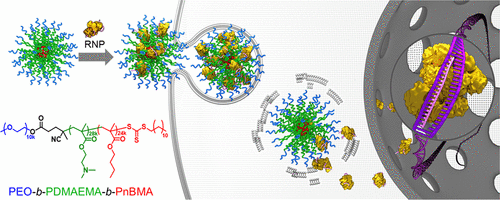Block Polymer Micelles Enable CRISPR/Cas9 Ribonucleoprotein Delivery: Physicochemical Properties Affect Packaging Mechanisms and Gene Editing Efficiency.
Published in Macromolecules, 2019
Recommended citation: Tan, Z., Jiang, Y., Ganewatta, M.S., Kumar, R., Keith, A., Twaroski, K., Pengo, T., Tolar, J., Lodge, T.P., Reineke, T.M., (2019) Macromolecules, 52, 21, 8197-8206.

Gene editing with CRISPR/Cas9 is revolutionizing biotechnology and medical research, yet affordable, efficient, and tailorable delivery systems are urgently needed to advance translation. Herein, a series of monodisperse amphiphilic block polymers poly[ethylene oxide-b-2-(dimethylamino) ethyl methacrylate-b-n-butyl methacrylate] (PEO-b-PDMAEMA-b-PnBMA) that housed three PEO lengths (2, 5, and 10 kDa) and a variant lacking PEO (PDMAEMA-b-PnBMA) were synthesized via controlled radical polymerization and assembled into well-defined spherical cationic micelles. The cationic micelles were complexed via electrostatic interactions with Cas9 protein/guide RNA ribonucleoproteins (RNPs) that exhibit anionic charges due to the overhanging RNA. The resulting micelleplex formulations in both phosphate-buffered saline (PBS) and water were screened via high content analysis for gene editing efficiency. The micelle variant with the 10 kDa PEO block offered the highest gene editing performance and was advanced for in-depth characterization. For the first time, quantitative static and dynamic light scattering characterization and cryogenic transmission electron microscopy images of Cas9 protein/guideRNA RNP loading into well-defined micelleplex nanoparticles are revealed, where the formulation solvent was found to play a major role in the physicochemical properties and biological performance. In PBS, the solutions containing the micelles (63 triblock polymers per micelle) were assembled with the Cas9 protein/guideRNA RNP payloads offering uniform loading of 14 RNPs per micelleplex and moderate editing efficiency; this homogeneous system offers promise for future in vivo/preclinical applications. Interestingly, when the uniform micelles were formulated with the RNP payloads in water, larger multimicelleplex nanoparticles were formed that offered double the editing efficiency of Lipofectamine 2000 (40% gene editing) due to the rapid sedimentation kinetics of the larger colloids onto adherent cells, offering promising in vitro, ex vivo, and/or cell therapy applications. This work presents the first quantitative demonstration of tailorable block polymer micelle formulations for advancing CRISPR/Cas9 RNP delivery and fundamental correlation of the solutions physics to biological performance. Download paper here